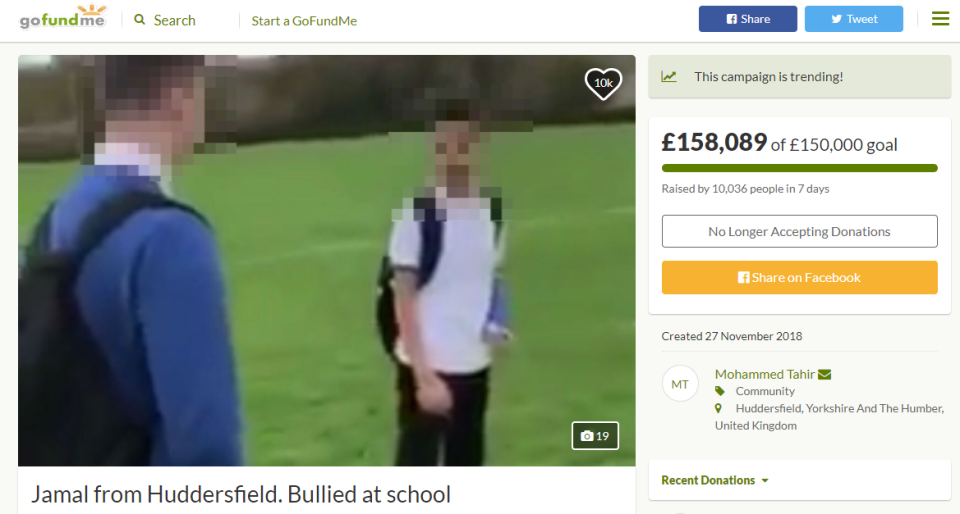By Khadija Khan
A bitter reality: British children feel unsafe in their schools. They become targets of bullying in one way or another.
The education system lacks the teeth to rescue these children from the suffering they face, despite knowing the negative and, often, lifelong impact on them.
A recent incident that has caught everyone’s attention is one that took place in Almondbury Community School in Huddersfield, West Yorkshire, where a teenage boy’s despicable demonstration of power over a vulnerable, Syrian boy soon drew media attention and caused uproar amongst people.
This incident should be prompting the authorities to take the strongest measures to protect innocent children such as Jamal and his sister from being harassed in schools.
As Jamal, 15, told the media, he had written to several bodies including the school itself, West Yorkshire Police and the Department for Education (DfE) three weeks before the fatal attack — but all in vain.
Bullying is akin to any other trauma; it also brings along shame, self –loathing, depression and violent or suicidal. This tragedy may begin at schools but stays with them throughout their life.
Therefore, Jamal’s case should have been seen primarily as a case of bullying, with the school’s superiors being held accountable for what happened and why have they failed to prevent such an incident in the first place.
The outpouring rage and condemnations from all sections of British society could have been used for calling out bullying culture in schools.
But since the bullied boy is a Muslim, Syrian refugee and the alleged attacker is a “white privileged boy,” most of the concern seems to be with scoring points and playing in to identity politics, rather than addressing the real menace of unrestrained bullying in British schools.

Communities, some of them Muslim, came forward to defend Jamal and his family for the sake of religious brotherhood. Some came forward to condemn the bully by relentlessly mentioning his ethnicity to point out the “racist” nature of Britain.
This is how a case that should have been about the well-being of children, regardless of their caste, colour or creed, has been reduced to identity politics.
Jamal’s religious beliefs, race, ethnicity and physical appearance may have caused verbal and violent bullying against him but such vicious acts are clearly not limited to a specific group of people. Ever-growing incidents of bullying are affecting children’s lives indiscriminately.
A DfE report showed that 40% of young people were bullied in the last 12 months. Research from the Anti-Bullying Alliance in 2016 showed that disabled children and those with special educational needs were three times more likely to both be bullied and bully others.
The mother of 10-year-old Lilly-Jo Caldcott in Worcestershire said she had tried to kill herself – by overdosing on pills – the day before her birthday because she was being bullied at school.
Earlier this year, Mariam Moustafa, an 18-year-old, engineering student, was assaulted in Nottingham by a gang of girls on a bus. Mariam was beaten severely until she lost consciousness and, sadly, did not survive the horrific injuries.
In 2016, 16-yearold Dagmara Przybysz’s dead body was found at her school in Cornwall. Her friends hinted that she had faced immense racist bullying in the school and had also discussed her tragic experiences on social media two years before she died.
These cases are tip of the ice berg. Children who are badly bullied never want to return to their schools.
Despite having many policies and measures in place, the incidents of bullying in schools are often disregarded by the staff. Children are told to ignore the bullies and move on, which is why many cases go unregistered and unnoticed.
It is this irresponsible attitude that emboldens bullies and makes bullied children go through hell.
Both sides have used Jamal’s story for their own agenda. On the one hand, there are those who will use to suggest that “racist” Britain will never accept refugees or foreigners. This rhetoric will, in some situations, lead to the bullied person feeling even more isolated and that Britain is not his or her home – a tactic used by some Islamist groups.
On the other side, the former EDL leader Tommy Robinson played the “us vs them” card, claiming Jamal had attacked a “white girl”. It played into the poisonous far-right narrative that “white children” do not matter. Jamal’s family are now suing Robinson for his remarks.
It is high time to narrate to families such as Jamal’s the true spirit of British values, which we observed when nearly £160,000 was raised for Jamal’s family, with a portion going to refugee charities.
Bullying is neither a part of childhood, nor an issue for bigots or any other person to manipulate. We need to break out of that and find a way to help child victims, and not allow some to play identity politics with their vulnerabilities.
*Main Pic Credit: Dan Rowlands / South West News Service.

Khadija Khan is a journalist and commentator based in Germany. You can follow her on Twitter.


The most obvious and blatant set up ever by ultra aggressive Muslim activists.
A bit of water poured on a kid’s face – the same kid who had attacked a white girl only a few weeks earlier – and it’s national news. Yet when a little white boy, Aaron Dugdale, is bullied by Pakistani kids to the point of committing suicide, there are no Sedaa articles for that.
How about doing a post on how white girls are groomed for rape and torture in British schools? Or does that not fit the victim narrative?